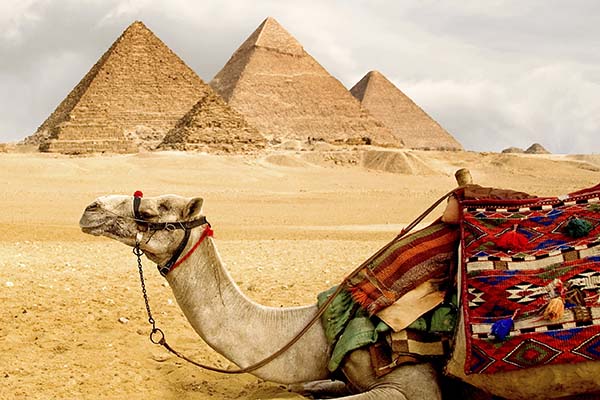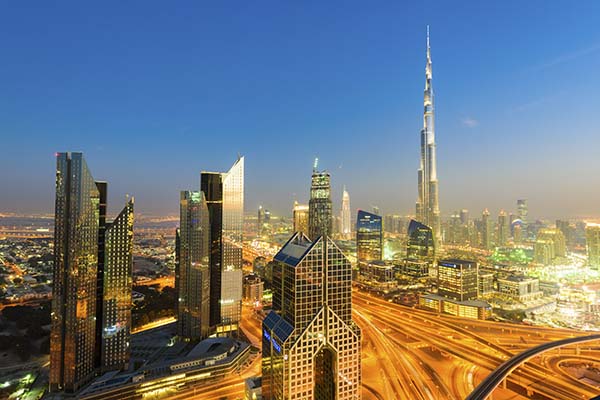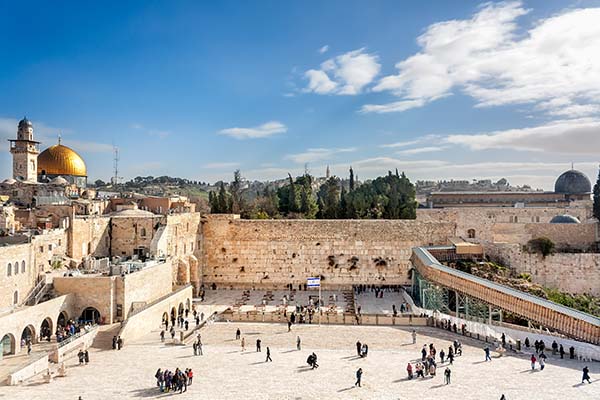







Middle East
With an incredible collection of both modern and ancient cities, monuments, and architecture, the Middle East is a convergence of history and soul. The Middle East is the region that connects Western Asia and North Africa, and is usually regarded with both Turkey and Egypt, along with Iran and the transcontinental countries in between. Largely covered with desert – including the Sahara – it gathers the Nile River, Persian Gulf, and the Turquoise Coast. A religious mecca, it was here that Christianity, Judaism, and Islam all originated. People come from around the world to explore the biblical sites and walk the pilgrimage from Jerusalem to Bethlehem. Or wander in awe through the Pyramids of Giza, cheer on a camel in a race in Qatar, and swim amongst the dolphins near coral reef at Oman. From the Petra ruins in Jordan to the Burj Khalifa skyscraper in Dubai, you’ll trace the earth’s past and glimpse the future in the Middle East.
Did You Know?
- The largest ethnic group in the Middle East are Arabs.
- In 2/3 of Middle Eastern countries, more women than men attend universities.
- Just a few hundred years ago, women in Turkey could legally divorce their husbands if he didn’t provide them with enough coffee.
- In 1963, a Turkish man knocked down a wall of his home, and discovered a mysterious room. This quickly turned into the discovery of an intricate tunnel system and cave-like rooms, which is now known as the ancient Derinkuyu underground city in Turkey.
- Many countries in the Middle East are wealthy because they have large quantities of crude oil, with 80% of the world’s accessible oil reserves coming from Saudi Arabia.
- One third of the plant life on the island of Socotra (Yemen) is found nowhere else on the planet, and the island has been described as “most alien-looking place on Earth.
- The coffee term “mocha” derives its name from the city of Mocha, Yemen, which was previously the primary port for exporting Arabian coffee to the world.
- The most widely spoken languages in the Middle East are Arabic, Persian, Turkish, Berber and Kurdish.
- An estimated 350 million years ago, there was a 20 foot tall mushroom that existed in Saudi Arabia, and likely the largest living thing on dry land at that time.
- Saudi Arabia is known for camel-back riding in their deserts, but actually imports sand and camels from Australia.
- Movie theaters have been banned in Saudi Arabia since the 1980s.
- “Muhammad” is the #1 most popular baby name in the world, with approximately 150 million men and boys named for the prophet of Islam.
- Over one third of the population of the Lebonon (1.5 of 4 million in population) have had plastic surgery procedures.
- Abu Dubai arguably has the greenest building in the world, which is structured like a city with no cars and no carbon emissions at all, with an exterior covered in what looks like hundreds of parasols.
Travel Tips
Entry requirements vary, but most countries in The Middle East require a passport that is valid for at least six months beyond the date is required to enter the. Many countries also require a visa. If you’re a U.S. citizen on personal travel of 30 days or less, you can often obtain a no fee visitor visa upon arrival. You may also want to consider the order of countries you want to visit, as having an Israel stamp on your passport will mean no entry into Iran or Lebanon. If you plan to visit Arab countries after visiting Israel, you may be able to ask the customs official not to stamp your passport, but make sure you ask before you get the stamp!
There are zones within the Middle East that are not safe or even allowed for travel. Check the US State Department for their recommendations and travel alerts, as they give up to date warnings as situations develop.
They also suggest that you enroll in the Smart Traveler Enrollment Program https://step.state.gov/step/ and check with the U.S. embassy or consulate of the countries you plan to visit, or contact your travel expert to guide you. https://www.usembassy.gov/
The Middle East is very hot and dry, and the differences in the seasons usually consist of nothing more than a difference in temperature. There are some mountainous areas that get cooler and can actually reach freezing temperatures in the winter months. Spring is usually the best time to visit, when temperatures are pleasantly warm and even give a show of wildflowers in some regions. The holiday season from Christmas to New Years is also a popular time to travel here. The desert regions can be unbearably hot in the summer months, and not recommended. Beyond weather considerations, when planning what to wear you’ll want to keep in mind that each country has their own set of traditions and customs, and attitude towards dress can vary greatly. Do your research and ask your travel expert for guidance for the areas you plan to visit.
Most of the countries in the Middle east each have their own official currency. It’s best to bring your credit and debit cards, which are widely accepted in populated cities and areas. Some smaller merchants and remote areas will accept cash only, so be prepared to use the ATM machines to carry a small amount of local cash in case it’s necessary.
Your mobile phone is the best way to stay connected in the Middle East. Contact your cell phone provider before you travel, to see if they have an international plan for the area you’re traveling too. Depending upon the carrier, can be expensive and unreliable, so you may consider getting an international SIM card and use a local prepaid plan with a provider in the
country you’re visiting. You may also need to buy or rent an ‘unlocked’ phone to use with a SIM card. Skype is another great option for phone or video calls, where there is WiFi. There are some areas in the Middle East where WiFi is not available, so if you have a SIM card, you have a much better chance of consistent connectivity.
Taxis are prolific and arguably the best way to get around town in the Middle East. They’re found in almost any Middle Eastern city and are so convenient and economical, that shared taxis may be even more so than taking the bus! There is a public bus and sparse train transportation in some areas, but many are outdated. Flying isn’t always possible for going from country to country either, so do your research on your planned route.
It’s important to also note that Muslims are required to pray five times throughout the day, and because much of the population are Muslims, you may need to work around their prayer schedule if you are there for business meetings.